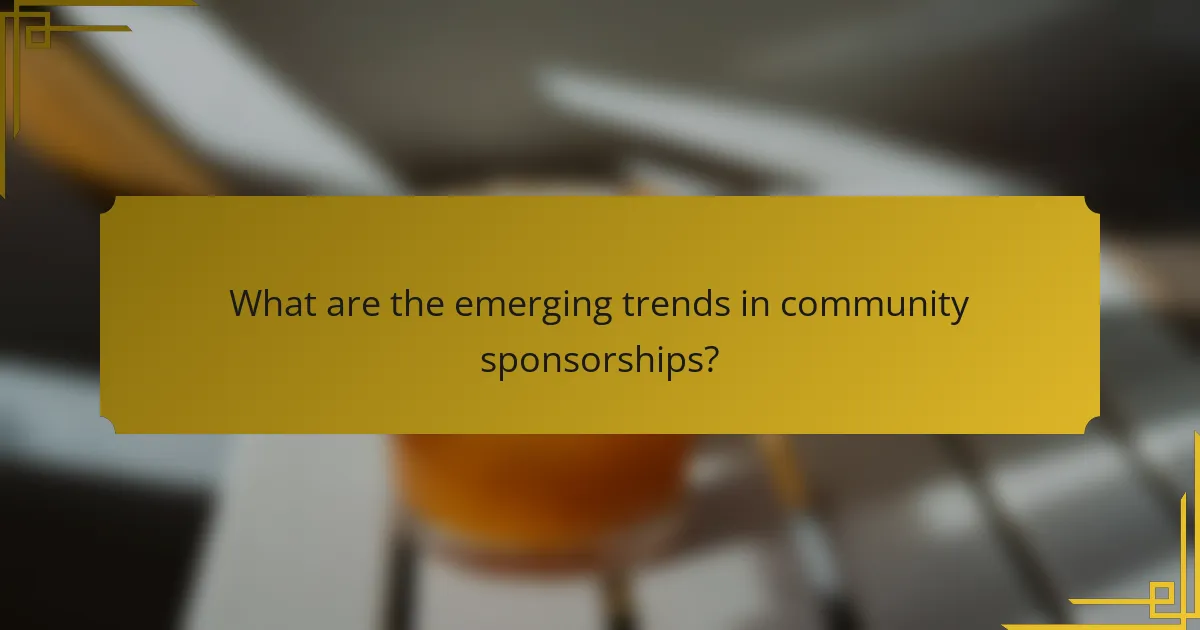Sponsorship opportunities in Los Angeles present a unique chance for brands, local businesses, and community partners to collaborate and thrive. By partnering with local sports teams, community events, and nonprofit organizations, brands can boost their visibility while positively impacting the community. Engaging in these initiatives not only strengthens community ties but also allows businesses to connect with diverse audiences and explore new customer bases.

What are the best sponsorship opportunities for brands in Los Angeles?
The best sponsorship opportunities for brands in Los Angeles include partnerships with local sports teams, community events, and nonprofit organizations. These avenues allow brands to enhance their visibility, engage with diverse audiences, and contribute positively to the community.
Local sports teams sponsorship
Sponsoring local sports teams in Los Angeles can significantly boost brand recognition. Teams often have dedicated fan bases, providing brands with access to a wide audience during games and events.
Consider options like jersey sponsorships, in-stadium advertising, or promotional nights. Costs can vary widely, typically ranging from thousands to millions of USD depending on the team’s popularity and league.
Community events partnerships
Partnering with community events, such as festivals or cultural celebrations, offers brands a chance to connect with local residents. These events often attract large crowds, making them ideal for brand exposure.
Brands can participate through sponsorship packages that may include booth space, promotional materials, or event branding. Costs can range from a few hundred to several thousand USD, depending on the event’s scale and reach.
Nonprofit collaborations
Collaborating with nonprofits in Los Angeles allows brands to align with causes that resonate with their values while enhancing their corporate social responsibility image. This partnership can involve financial support, in-kind donations, or volunteer efforts.
Brands should choose nonprofits that reflect their mission and audience. Sponsorship levels can vary, often starting from a few thousand USD for smaller organizations to much higher amounts for well-known charities. Engaging in these collaborations can lead to positive community impact and increased brand loyalty.

How can local businesses engage with community partners?
Local businesses can engage with community partners by collaborating on initiatives that benefit both parties and strengthen community ties. This can involve various strategies such as co-hosting events or providing special offers to community members.
Co-hosting local events
Co-hosting local events is an effective way for businesses to connect with community partners and enhance visibility. By working together, businesses can pool resources, share marketing efforts, and attract larger audiences. Consider events like fairs, workshops, or charity drives that resonate with local interests.
When planning an event, ensure that both parties have clearly defined roles and responsibilities. This includes logistics, promotion, and follow-up activities. A successful collaboration can lead to increased foot traffic and customer engagement for both businesses involved.
Offering discounts for community members
Offering discounts for community members is a straightforward way to foster goodwill and encourage local patronage. Businesses can create special promotions or loyalty programs that reward residents for their support. This not only boosts sales but also strengthens community relationships.
Consider implementing a tiered discount system based on community involvement or participation in local events. For example, a business might offer a 10% discount for members of a local organization or a 15% discount during community events. Clear communication about these offers is essential to maximize participation and impact.

What are the benefits of sponsorship for brands?
Sponsorship offers brands a strategic way to enhance their market presence and connect with target audiences. By aligning with events, organizations, or community initiatives, brands can leverage visibility, foster goodwill, and tap into new customer bases.
Increased brand visibility
One of the primary benefits of sponsorship is increased brand visibility. By sponsoring events or local initiatives, brands can showcase their logos and messaging to a wider audience, often reaching thousands of potential customers. This exposure can be particularly effective in community settings where local engagement is high.
Brands should consider the type of events they sponsor. High-traffic events, such as festivals or sports tournaments, can provide significant visibility, while niche events may attract a more targeted audience. It’s essential to choose sponsorships that align with brand values and target demographics.
Enhanced community relations
Sponsorship fosters stronger community relations by demonstrating a brand’s commitment to local causes and initiatives. When brands support community events, they build trust and goodwill among residents, which can lead to increased customer loyalty. Engaging with the community can also enhance a brand’s reputation.
Brands should actively participate in sponsored events, not just financially but also through volunteer efforts or product donations. This involvement can create meaningful connections with community members and showcase the brand’s dedication to local development.
Access to new customer segments
Through sponsorship, brands can access new customer segments that may not have been reachable through traditional marketing channels. Events often attract diverse audiences, allowing brands to introduce their products or services to potential customers who share similar interests.
To maximize this benefit, brands should analyze the demographics of the event’s audience and tailor their messaging accordingly. Offering promotions or samples at events can also encourage new customers to engage with the brand and make purchases.

What criteria should brands consider when choosing sponsorships?
Brands should evaluate several key criteria when selecting sponsorship opportunities to ensure alignment with their goals and values. These include the alignment with brand values and the demographics of the target audience, which can significantly impact the effectiveness of the partnership.
Alignment with brand values
Choosing sponsorships that align with brand values is crucial for maintaining authenticity and credibility. Brands should look for partnerships that reflect their mission, vision, and ethical standards, as this can enhance brand loyalty among consumers who share similar values.
For example, a company focused on sustainability might sponsor environmental initiatives or events that promote eco-friendly practices. This alignment not only strengthens the brand’s image but also resonates with a like-minded audience, creating a more impactful connection.
Target audience demographics
Understanding the demographics of the target audience is essential when selecting sponsorships. Brands should analyze factors such as age, gender, income level, and interests to ensure the sponsorship reaches the right people. This alignment can lead to higher engagement and conversion rates.
For instance, a brand targeting young professionals may choose to sponsor events popular among this demographic, such as tech conferences or networking events. By focusing on the right audience, brands can maximize their return on investment and foster meaningful relationships with potential customers.

How can brands measure the success of their sponsorships?
Brands can measure the success of their sponsorships through various metrics that reflect engagement, visibility, and financial impact. Key methods include brand awareness surveys and sales performance analysis, which provide insights into how sponsorships influence consumer perception and purchasing behavior.
Brand awareness surveys
Brand awareness surveys are a direct method for assessing how well consumers recognize and recall a brand associated with a sponsorship. These surveys can be conducted before and after the sponsorship event to measure changes in brand recognition and recall rates.
When designing a survey, consider including questions that gauge familiarity with the brand, perception changes, and overall sentiment. A common approach is to use a Likert scale, allowing respondents to express varying degrees of agreement or recognition.
Sales performance analysis
Sales performance analysis evaluates the financial impact of sponsorships by comparing sales data before, during, and after the sponsorship period. Brands should track key performance indicators (KPIs) such as revenue growth, average transaction value, and customer acquisition rates.
To effectively analyze sales performance, consider segmenting data by demographics or geographic regions to identify specific areas of impact. Additionally, correlating sales spikes with sponsorship activities can provide clearer insights into the effectiveness of the investment.

What are the emerging trends in community sponsorships?
Emerging trends in community sponsorships focus on innovative approaches that enhance brand visibility while fostering local engagement. Brands are increasingly leveraging digital platforms and aligning with sustainability initiatives to connect with their audiences meaningfully.
Digital and virtual sponsorships
Digital and virtual sponsorships have gained traction as brands seek to reach wider audiences through online channels. This includes sponsoring virtual events, webinars, and social media campaigns that allow for real-time interaction and engagement.
For example, a local business might sponsor a virtual festival, providing branded content and promotional materials that participants can access online. This approach not only increases visibility but also allows for measurable engagement metrics, such as clicks and shares.
Focus on sustainability initiatives
Brands are increasingly prioritizing sustainability in their sponsorship strategies, aligning with community values and environmental goals. This trend involves supporting local projects that promote eco-friendly practices, such as community gardens or clean-up events.
For instance, a company might partner with a local non-profit to sponsor a tree-planting initiative, showcasing their commitment to sustainability while enhancing community relations. This not only boosts brand reputation but also resonates with consumers who prioritize environmental responsibility.

How can brands leverage social media for sponsorship promotion?
Brands can effectively use social media to enhance sponsorship promotion by creating engaging content that resonates with their target audience. This approach not only increases visibility but also fosters a deeper connection with potential customers.
Engaging content creation
Creating engaging content is crucial for brands looking to promote sponsorships on social media. This can include eye-catching visuals, compelling stories, and interactive posts that encourage audience participation. For example, brands can share behind-the-scenes footage of sponsored events or run contests that invite followers to share their experiences.
Utilizing various formats such as videos, polls, and infographics can significantly boost engagement rates. Aim for content that is relatable and aligns with the interests of your audience, ensuring that it reflects the values of both the brand and the sponsorship.
Collaborative campaigns with partners
Collaborative campaigns with partners can amplify the impact of sponsorship promotions. By teaming up with local businesses or community organizations, brands can reach a wider audience and create a more significant buzz around their sponsorships. Joint promotions, such as co-hosted events or shared social media takeovers, can be particularly effective.
When planning collaborative campaigns, it’s essential to establish clear goals and responsibilities for all parties involved. This ensures that the partnership is mutually beneficial and that the messaging remains consistent across all platforms. Consider leveraging each partner’s strengths to enhance the overall campaign effectiveness.
